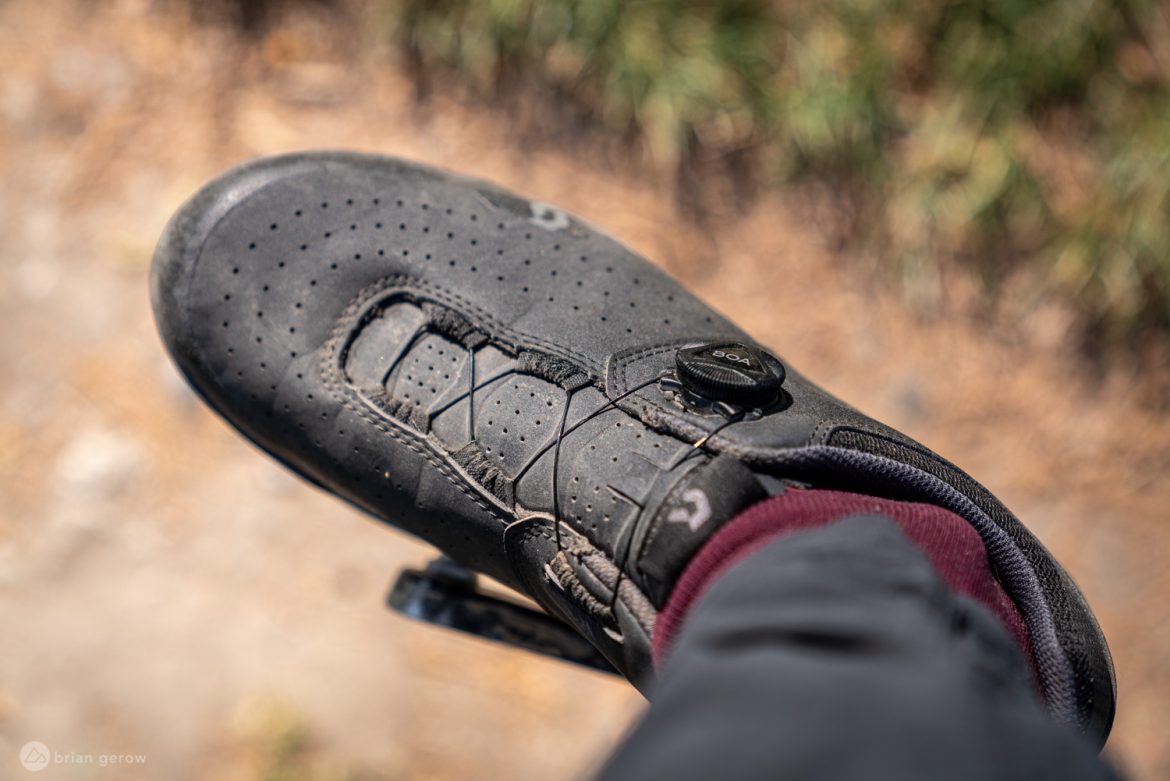
A volt is an International System of Units measure of the electric potential between two points, which seems an appropriate name for mountain bike shoes that are designed to create a positive connection. On first pedal the Scott Volt gravity shoes are notably comfortable, with a snug fit that’s easily adjusted via their single BOA dial. The svelte tongue is made of a wide piece of leather-like fabric that dips deep enough on either side to keep it form bunching or causing pressure points on the upper foot.
This black clipless set weighs 480g per foot and retails for €129.90. There is an identical flat-pedal model that can be found for around €90 in a variety of colors, and numerous similar models with laces or two separate BOA dials.
These Volt clipless shoes have a clean aesthetic, and very little stitching in the areas where seams regularly wear thin. All of the perforated areas, including the tongue and upper toebox, are free of padding, leaving them to breathe easy and cool off your kickers. The toe cap, in contrast, is rigid and ready for impacts, providing enough stiffness that it can’t be folded or dented with mere hand strength.
The fit of my size 43 shoe is spot on, with a comfortable amount of space in the toe box for airflow or extra socks. There is no internal grip or other fancy retention system to prevent heel-slip while walking, but Scott has managed to dial in the upper shape so that it doesn’t need anything extra. My narrow heels slide out of most shoes, no matter how I cinch them, but the Volt heel cup stays put. It’s nice to session jumps or hike-a-bike without your shoes threatening to slip off all the while.
BOA sent these shoes for testing, and their confidence comes with good reason. The black wire that tightens them up is so simple and quick to use while pedaling that is’t hard to understand why we would want anything else. The long lace guides distribute pressure evenly, and I have yet to want any additional adjustment. The textured dial is easy to actuate with winter gloves on, and I haven’t had any issues with it binding in muddy conditions.
The glaring downside of this retention system is that if you smack that dial hard enough on a tree or rock it will break, and you’ll be left with a shoe that flops around between the pedal and your foot. It’s good to carry a pair of heavy zip ties folded inside the handlebars regardless, and this potential issue makes them all the more valuable. Word is, if you send BOA a message about busted product they will ship out a replacement posthaste.
Like frame geometry, sole grip is something a lot fo companies have dialed in — at least for clipless applications. The Scott “sticki” rubber has plenty of grip for walking on rocks and steep slopes, and the heel and toe lugs are spaced further apart for decent traction. These aren’t a hiking boot by any means, but the designers undoubtedly considered walkability in their process. The Scott brand is based in Switzerland after all, where alpine summit trailheads are sometimes reached on foot.
The shoe’s removable insole has a neutral pitch, with no outward lean or odd angles that can cause knee pain for some folks. Between the thick sole and reinforced cleat channel you can faintly tell where the cleat is located on your foot, and I haven’t experienced any hotspots or other discomfort. There seems to be plenty of impact resistance in the sole, whether that impact comes from a stomp or strike.

In addition to the increased toe and sole protection, there is an average amount of ankle padding to prevent bruising from the cranks or trail projectiles. Scott has yet to design a shoe with a higher inner ankle support for frame protection, but with more brands moving that way they may have something in the future. As it stands both large ankle bones, the lateral malleolus and medial malleolus, are left exposed to the elements.
The Volt cleat channel is quite similar to that on a Shimano gravity shoe, with ramped leading and trailing edges to guide your foot into place. It’s also a touch deeper than some, and riders may need a shim under their cleat in order to achieve their preferred release pressure. With the usual midfoot cleat placement and a long mounting channel riders should be able to find their sweet spot with the pedal spindle. Scott rates the Volt at a 6 out of 10 stiffness, and I’d say that’s spot on. You can just barely feel the cleat plate while sprinting, and the sole doesn’t squish around the pedal on harsh landings. In terms of sole rigidity alone, this would make a fine enduro racing shoe.

If you’re in the market for a new gravity pair, with subtle looks and undoubtable comfort, the Volt is a great option. These have felt fantastic on long pedals through nearly all conditions, and apart from true XC racing they should work well for most adventures. As ever, don’t forget your zip ties. MSRP: $99.99.













2 Comments
Apr 10, 2021
Also, I can confirm Boa is quick to send free kits when you need them. You just send them a pic and that's about it.
Apr 12, 2021